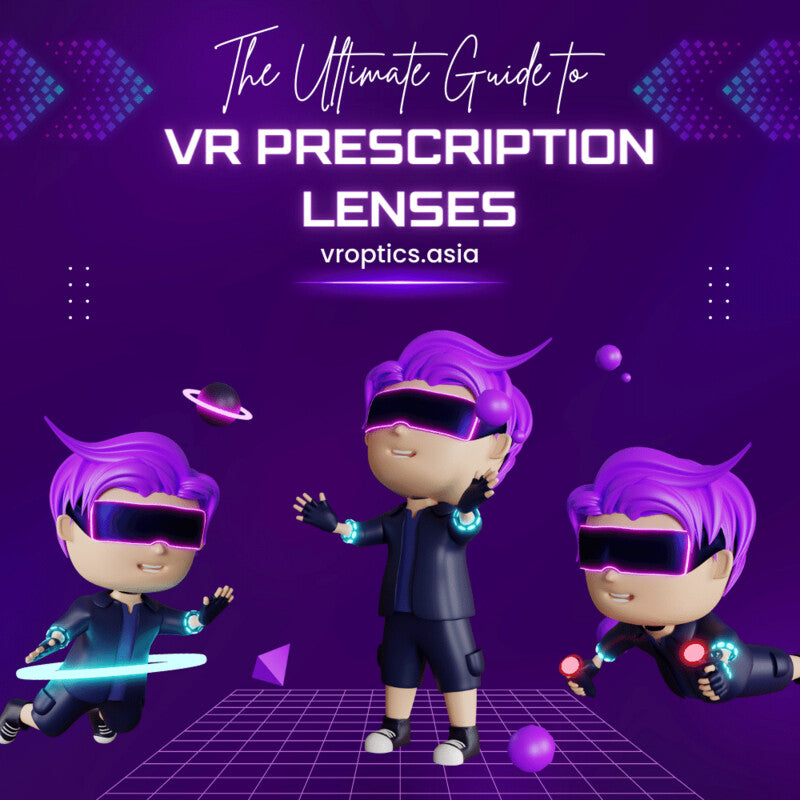
The Ultimate Guide to VR Prescription Lenses - VR Optics Asia
Share
(This point was originally written on the 6th June 2023, on our old website. This information is still relevant today!)
Happy 6/6, everyone! If you reside in a country that uses the "6/6" convention for eye tests (such as in Singapore), you'll understand when I say that today always reminds me of a day to celebrate the profession of eye care professions. For this very reason, today will be the chosen day that I'll dedicate to writing a comprehensive article about what I provide: virtual reality (VR) prescription lenses.
This comprehensive guide will explore what VR prescription lenses are and how they can enhance your virtual reality experience.
1. What are VR Prescription Lenses
First and foremost, what are VR prescription lenses? Why do we even need prescription lenses for VR?
It is because even though the screen is physically set to be just a few inches away from your eyes, the lenses that you are looking through in the headset are designed to project the virtual image at a distance away (in most headsets, it is around 1~2 metres), far enough so that it doesn't cause eye strains. Furthermore, anything closer than six inches or closer from the eyes can't typically be brought into focus due to the limitations of the focusing muscles of our eyes. For this reason, since our eyes respond to the screens like distant objects, anyone who requires corrective lenses to see things at a distance will still need them in VR.
VR prescription lenses can be inserted into a virtual reality (VR) headset to allow users with vision problems such as myopia, hyperopia or astigmatism to see clearly. Even though spectacle wearers can solve their vision issues when wearing glasses inside their headsets, they often experience discomfort and reduction in the field of view and possibly risk scratching the internal lenses permanently if both lenses rub onto each other.
VR prescription lenses are a solution to this problem. They are custom-made to fit the user's eye prescription and can be easily inserted into the VR headset. This allows users with vision problems to enjoy VR without any of the issues above.
2. Benefits of using VR Prescription Lenses
There are several benefits to using VR prescription lenses compared to wearing glasses underneath, expanding on top of the abovementioned reasons.
- 1. Comfort
VR headsets can be uncomfortable to wear for people with glasses. Trying to fit glasses in between them is often awkward and challenging, and glasses that press onto the sides of our heads can be painful. The glasses' lenses can also fog up when it's too seated too close to our faces, making it difficult to see clearly. Contact lenses may arguably also help reduce the problem of the glasses fogging up inside the headset, but people may not want to go through the hassle of wearing their contact lenses at home or just for half an hour of VR time.
VR prescription lenses eliminate this problem by allowing wearers to see immediately upon wearing their VR headset without fitting their glasses in them. There is no additional pressure on the nose or at the sides of the face where the glasses used to be, allowing wearers to comfortably have their headsets seated on their faces.
- 2. Convenience

Another feedback I've gotten from customers is that it makes wearing VR a lot more convenient, and it's not hard to understand why. Before using VR prescription lenses, whenever users had to use their VR headsets, they had to pick up their glasses (if they weren't wearing them already) and squeeze them into their headsets. With VR prescription lenses, users can put on their VR headset and immediately experience clear and sharp visuals without the hassle of putting on their glasses. The only inconvenience is needing to find your glasses afterwards to see after removing the headset! (haha)
- 3. Protection
Lastly, in addition to just providing vision correction, VR prescription lenses can offer valuable protection against your expensive spectacle lenses and the delicate internal lenses of the VR headsets. Adding onto what has been mentioned earlier about scratches, VR prescription lenses can act as a protective barrier, shielding the internal lenses of the headset from any scratches or damages that could occur during intense gameplay or accidental collisions. This safeguard ensures the longevity and durability of your VR headset, extending its lifespan and preserving its optimal visual quality.
But fret not! People who do not wear glasses can also enjoy the benefits of prescription lenses for protection! Even if you do not wear glasses, you can benefit from VR lenses with zero power blue light protection. These lenses offer physical protection against scratches and help reduce the harmful effects of blue light emitted by VR screens, giving you comfort and allowing you to enjoy extended VR sessions with enhanced eye protection.
At VR Optics Asia, you can be assured that all our prescription lenses, zero-powered or not, will always come with blue light protection to shield your eyes against potential eye strain and fatigue from the VR screens.
3. How to choose the right VR Prescription Lenses
- 1. Consider Prescription
When choosing the right VR prescription lenses, one of the critical factors to consider is your prescription.
Generally, the higher your prescription, the higher the necessity to use higher index lenses (such as 1.6 or 1.67 lenses) to keep the prescription lenses thin and lightweight. Even though our prescription inserts can hold lenses with high prescriptions, ordering them with a high index option will make your lenses thinner and lighter than if ordered otherwise.
This is a guide below that you can follow. The "SPH" is the first number in your prescription.
1.56 Index: SPH -1.00 ~ -3.00
1.6 Index: SPH -4.00 ~ -6.00
1.67 Index: SPH -6.00 ~ -8.00
- 2. Consider the type of VR headset
This is well understood, but before you purchase VR prescription lenses, be sure that you are purchasing lenses for the same VR headset as the one you are using. That is because, across the different headsets, the prescription lenses (or rather the inserts used for them) differ due to the size of their eyepieces and lens designs. A Meta Quest 2 prescription lens will not fit a Meta Quest Pro or a Pico 4.
For now, no universal adaptor fits all the headsets, and each VR prescription lens is specific to the headset it is meant solely for. At VR Optics Asia, we provide VR prescription lenses for the Meta Quest 2, Meta Quest Pro, Pico 4, PlayStation VR2, and others.
4. Where to buy VR Prescription Lenses
When it comes to purchasing VR prescription lenses, various online and offline channels are available. However, most of these providers tend to be based in the US, where people situated in Asia may experience longer shipping times. Therefore, people residing near or within Southeast Asia countries can experience quicker shipping times by purchasing from us.
- Online:
- VR Optics Asia @ https://vroptics.asia
- Offline: (currently only exclusive to Singapore, though we are open to working with regional distributors!)
- Singapore:
- KJ Optometrists (PlazaSG): 68 Orchard Road, #04-52 Plaza Singapura, Singapore 238839
- KJ Optometrists (J10): 1 Woodlands Road, #01-19 Junction 10, Singapore 677899
- Singapore:
5. Conclusion
In conclusion, VR prescription lenses are the ultimate solution for enhancing your virtual reality experience while providing comfort, convenience and protection. By seamlessly integrating prescription lenses into your VR headset, you can say goodbye to the discomfort of wearing regular glasses and enjoy crystal-clear visuals without compromise. Consider your prescription and compatibility with your VR headset when choosing the right lenses.
Should you have any questions or need assistance with your order, our dedicated team is always ready to help. Contact us today to take your VR experience to the next level with premium prescription lenses tailored just for you!
